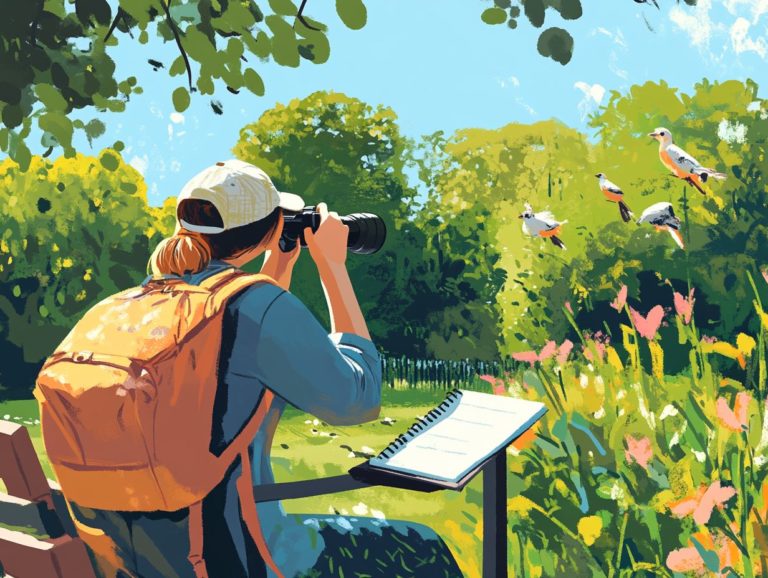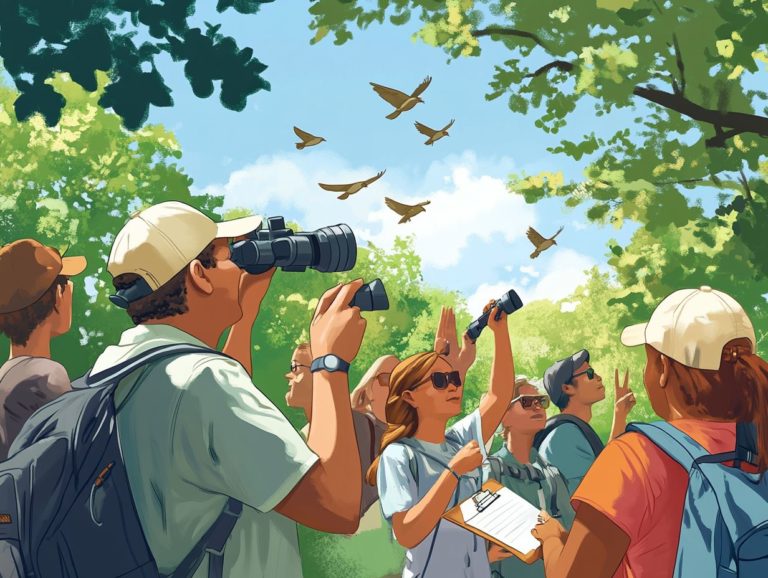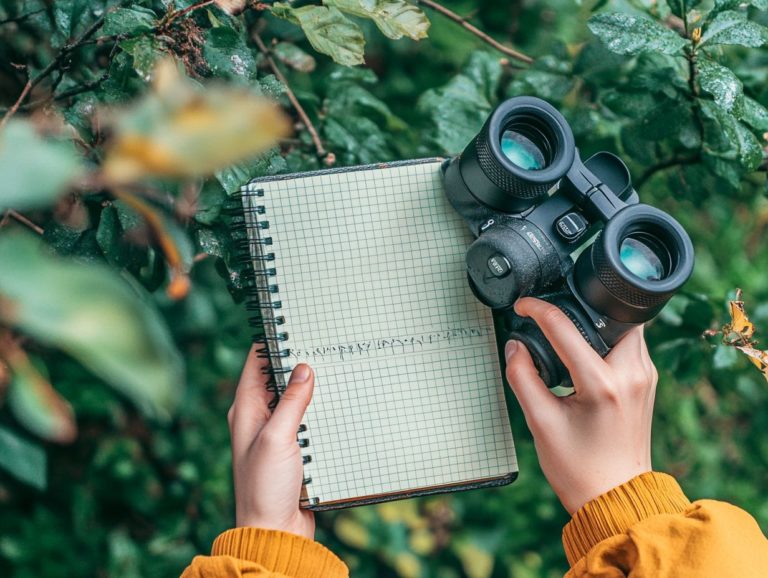What Role Do Bird Calls Play in Bird Watching?
Bird calls are the sounds produced by birds. They are essential tools for bird watchers and enthusiasts.
Learning to recognize these sounds enhances the bird-watching experience. It’s crucial for identifying various bird species.
Contents
Key Takeaways:
- Bird calls help identify birds while bird watching.
- Types of bird calls include songs, calls, and alarms.
- To recognize bird calls, listen for patterns, pitch, and rhythm.
The Importance of Bird Calls in Bird Watching
Bird calls are vital for identifying species like the American Robin and Northern Cardinal. They provide insights into these birds’ behavior, habitats, and migration routes.
Understanding these calls enhances enjoyment and awareness of avian life. This fosters greater appreciation for biodiversity and highlights the importance of conservation efforts.
Why Bird Calls are Essential for Bird Identification
Bird calls are key in identifying species in the field. Birders often rely on these sounds to improve their birding experience.
These vocalizations not only help identify species but also reveal social aspects of birds. Many calls announce territory claims, essential for bird society.
Birders can sharpen their skills using field guides or mobile apps like Audubon that feature audio recordings. Frequent listening and field time significantly enhance identification abilities.
The Different Types of Bird Calls
Bird calls refer to the sounds produced by various species, including the American Robin and Henslow’s Sparrow.
Exploring the Variety of Bird Sounds
The sounds made by birds are unique and diverse. Species like the Yellow-headed Blackbird and Carolina Wren demonstrate this variety.
Bird sounds can be classified into calls, songs, and alarms. Calls are short and help communicate within flocks, while songs are primarily for mating rituals.
Alarm calls, such as those of the Black-capped Chickadee, alert others to predators, aiding survival. Understanding these sounds enriches birdwatchers’ knowledge and expertise.
How to Identify Bird Calls
Bird call identification is possible through training and using bird call apps. This helps birdwatchers appreciate avian species and their behaviors more effectively.
It also raises awareness about birds and their habitats, contributing to conservation efforts.
Tips and Techniques for Recognizing Bird Calls
Bird enthusiasts can enhance their ability to recognize bird calls by employing various techniques. Pay attention to the pitch, rhythm, and patterns of sounds. These methods are particularly effective for identifying calls of common species like the American Robin and Northern Cardinal. This will improve their overall birding experience.
Active listening is a crucial component of these techniques. Focus on the sounds without distractions. Dedicating time each day to sit quietly in nature and absorb the sounds around you will greatly enhance your awareness of subtle differences between calls. Mnemonic devices can also aid in remembering calls by associating a sound with a memorable phrase or image.
Many technological tools are available, including bird call apps that offer audio samples and identification guides. Regular practice, whether through field trips or simply relaxing in your backyard, will not only reinforce your learning but also enhance your enjoyment of these beautiful sounds.
Using Bird Calls for Bird Watching
Bird calls enhance the bird-watching experience by strategically attracting birds, aiding in the observation of various species, fostering community building, and promoting environmental conservation. This is vital for helping local wildlife thrive.
Strategies for Attracting and Observing Birds
The most effective strategies for attracting and observing birds include using bird calls, selecting appropriate trails and habitats such as wetlands, and installing feeders filled with birdseed to draw them closer to observers.
It’s also important to choose the right time of day for birdwatching. Early mornings and late afternoons tend to be more productive, as many birds are more active during these times, particularly during their migration periods.
Understanding the seasonal patterns of the local bird population can enhance the experience. Whether in a quiet forest, a busy city park, or beside a tranquil lakeside, observers should remain patient and allow nature to reveal its wonders.
Recording and Sharing Bird Calls
Recording and sharing bird calls can not only document a person’s journey with birds but also aid in conserving their habitats, support research efforts, and track populations. This data can provide researchers with valuable insights into bird behaviors and distributions.
Tools and Platforms for Documenting Bird Sounds
There are several tools and platforms available for documenting bird sounds, including specialized apps like Audubon and Kenn Kaufman‘s resources, as well as community-driven databases that facilitate research. These resources offer user-friendly methods for recording and identifying bird calls.
For instance, Merlin Bird ID enables bird watchers to track their observations and leverage the expertise of fellow birding enthusiasts. Utilizing these technologies will significantly enhance conservation efforts, as the data collected through these apps can be invaluable for scientists monitoring population trends and habitat needs.
Join a local birding club today and connect with fellow enthusiasts! Participating in local birding clubs or online forums can help individuals connect with others who share their interests. This reinforces the vital link between personal enjoyment and community conservation initiatives.
Frequently Asked Questions
What Role Do Bird Calls Play in Bird Watching?
Bird calls play a crucial role in bird watching. They help bird watchers identify different bird species and locate them in their natural habitat, enhancing their overall experience and understanding of bird life.
Why are bird calls important in bird watching?
Bird calls serve as a form of communication for birds, and each species has its own unique call. By listening to and recognizing these calls, bird watchers can easily identify which birds are present in their surroundings.
Can bird calls also reveal the behavior of birds?
Yes, bird calls can provide important information about a bird’s behavior, such as their territoriality, mating calls, and alarm calls. This can offer valuable insights into the life and habits of different bird species.
Do bird calls vary depending on the time of day?
Yes, some bird species have specific calls for different times of the day. Daytime birds tend to be more vocal in the morning and evening.
Nocturnal birds, on the other hand, have distinct calls at night.
What other factors can affect bird calls?
Bird calls can change with the seasons, weather, and habitat. For example, birds often change their calls during the time they find partners or when defending their territory.
Weather conditions also impact the clarity and volume of their calls.
How can bird watchers use bird calls in their observations?
Bird watchers can use calls to attract birds and get closer for observation. They can also use recordings to identify unfamiliar species and learn more about their habits.






